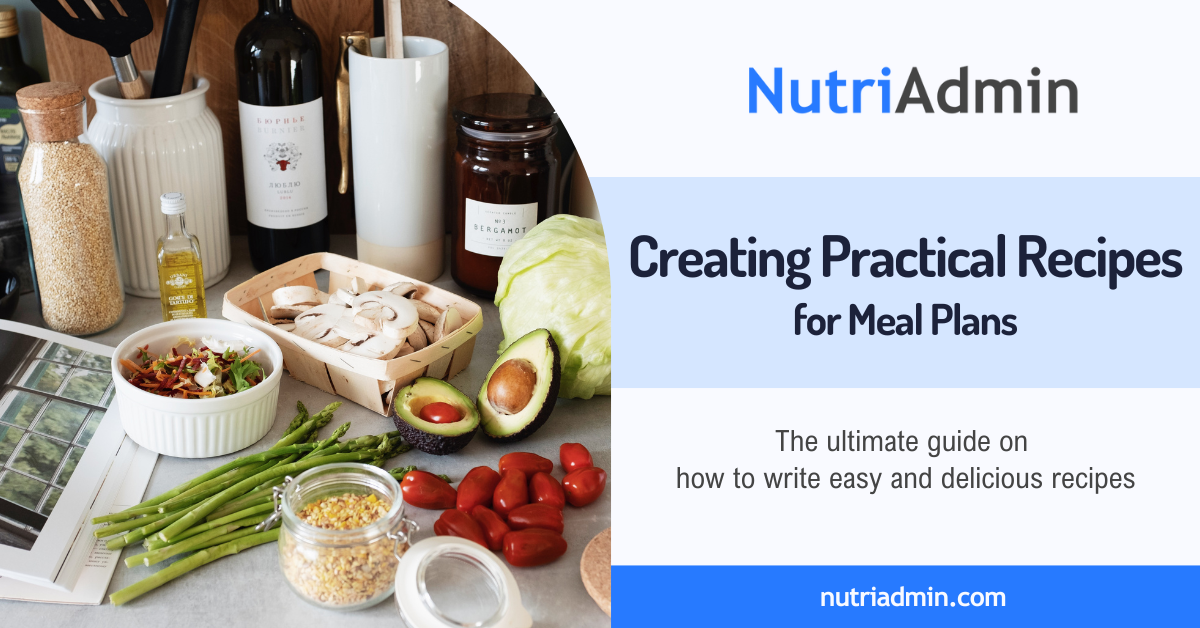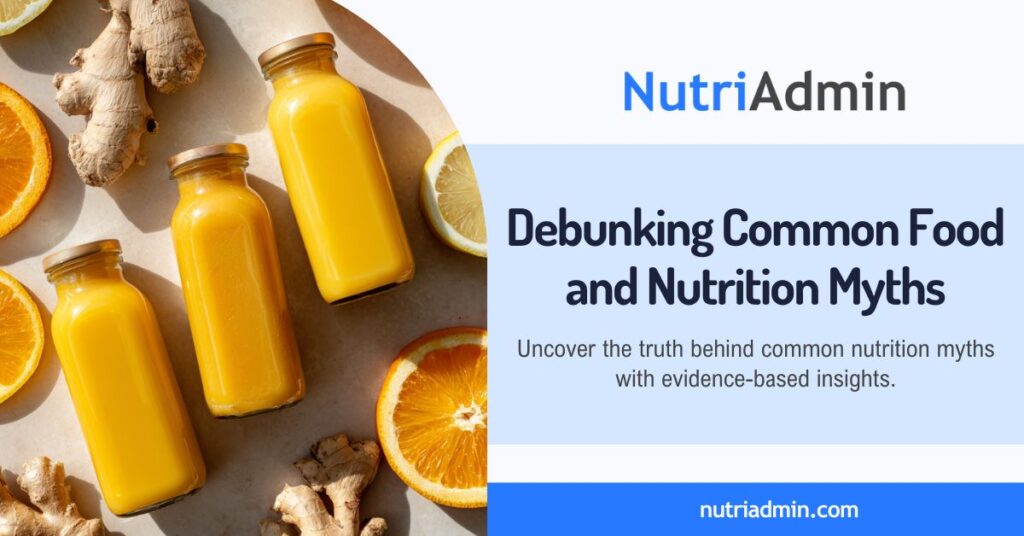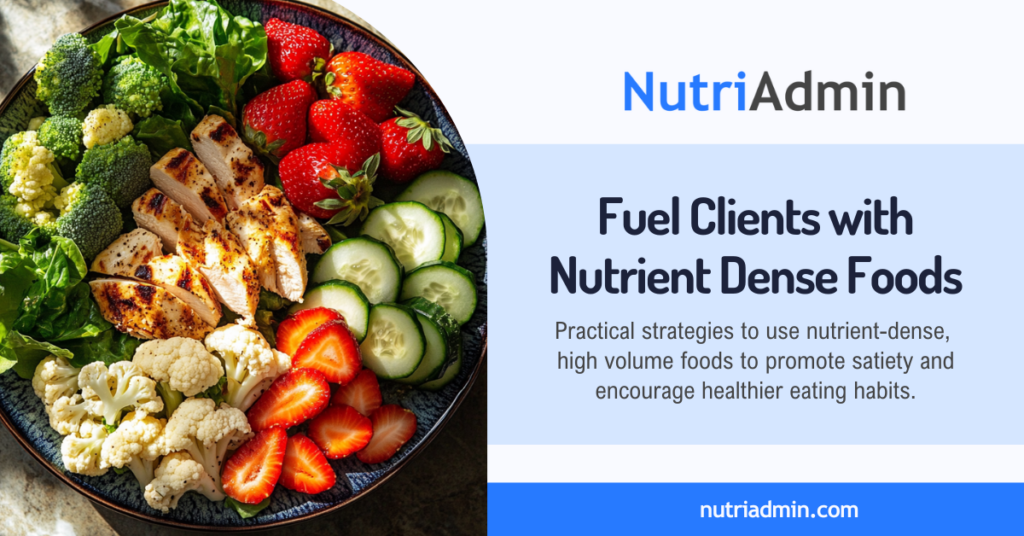Do you ever feel like you’re putting in all the effort to create the perfect meal plan for your clients, only to have them come back and say it’s too complicated or doesn’t suit their taste? As a nutrition or wellness professional, seeing your hard work go to waste can be frustrating. But what if there was a solution?
In this guide, we’ll show you how to make a recipe that is easy and tasty. We will guide you through the components of a recipe, explain how they are written, and provide you with comprehensive information on how to create recipes for meal planning. Additionally, we will provide tips on how you can make money through recipe creation.
This way, you can provide your clients with recipes that fit their unique preferences and lifestyles. Say goodbye to the frustration and hello to satisfied clients who are finally reaching their health and fitness goals!
- Who is this guide for?
- What is a recipe?
- How to Create Your Own Recipes for Meal Planning
- Things to Consider When Creating Recipes for Meal Planning
- How can you create recipes with nutrition information?
- How can you create recipes with your branding?
- Making Profit Through Recipe Creation
- Summary
- Frequently Asked Questions
Who is this guide for?
If you are a nutritionist, dietitian, personal trainer, or coach who offers or plans to offer meal-planning services to your clients, this guide is for you.
If you are an individual trying to make dietary changes and want to get ideas on what to eat, you can also benefit from this guide.
The writer of this article is not a culinary expert. I am a dietitian with a passion for all things food, including cooking and baking. I have also created and reviewed recipes for meal plans in NutriAdmin, a meal planning software for nutritionists, dietitians, and coaches.
Therefore, if you are a chef looking for ideas or guidance on creating your next unique cookbook, this article may not be for you.
What is a recipe?
A recipe is a set of instructions with a list of ingredients that serves as a guide to making a particular dish or drink. Recipes help ensure consistency in the quality and taste of dishes every time.
Recipes in meal plans can help clients who are not familiar with cooking. These provide all the necessary information about what ingredients are needed and how to prepare healthy meals that meet their nutritional and health objectives. They also serve as a guide that can help reduce stress during meal preparation by providing step-by-step instructions.
Parts of a Recipe
Knowing what should be in a recipe is important. This will help you make it more organized and professional. Knowing its components can also help ensure that clients can easily understand and follow it.
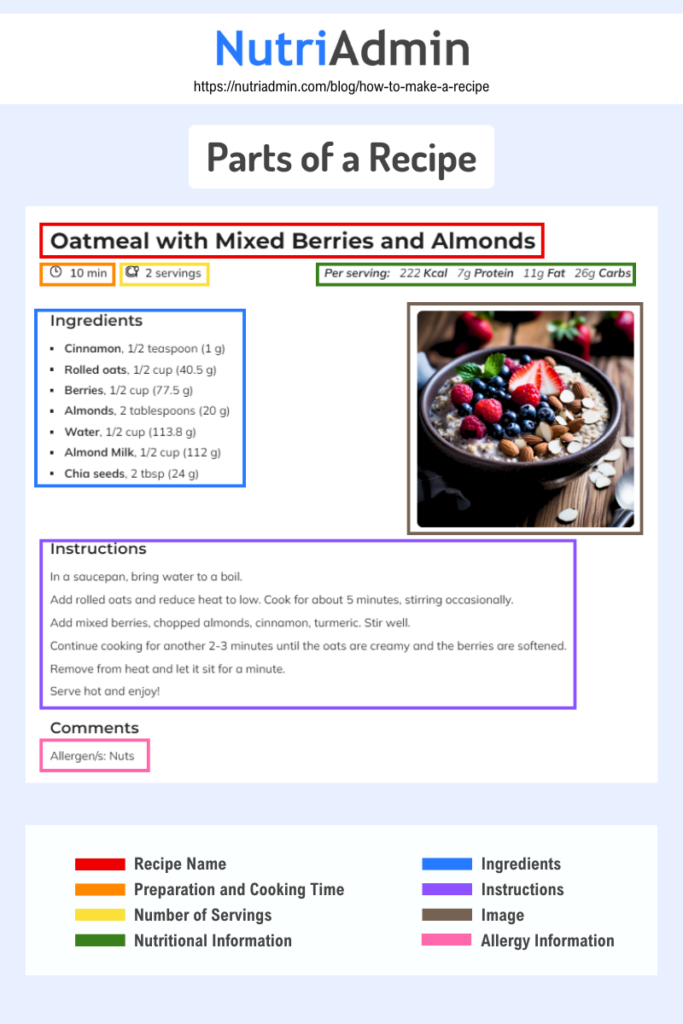
Recipe Name
The recipe name is the title of the dish you’re preparing. It’s usually a descriptive name that gives you an idea of the main ingredients or flavors involved.
Preparation and Cooking Time
This section provides an estimate of the total time required to prepare and cook the recipe. It typically includes two separate times: the preparation time (for tasks like chopping ingredients, mixing, etc.) and the cooking time (the time it takes to cook the dish on the stovetop, in the oven, or using any other cooking method).
Number of Servings
This information indicates how many portions or servings the recipe will yield. It’s helpful for adjusting the ingredient quantities if you need to make more or fewer servings.
Ingredients
Ingredients show the food items and their amounts needed for the recipe, typically listed in order of usage in preparation and cooking.
Instructions
This is the main body of the recipe, which provides a step-by-step guide on how to prepare and cook the dish. The instructions are usually numbered or listed in the order they need to be followed.
Image
Many recipes include one or more images that show what the finished dish should look like. These visual aids can be helpful for getting a sense of the desired appearance, presentation, or plating of the recipe.
Nutritional Information
This section provides details about the nutritional value of the recipe, typically including the number of calories, as well as the amounts of macronutrients (such as protein, carbohydrates, and fat) and sometimes micronutrients (like vitamins and minerals) per serving.
Allergy Information
If the recipe contains any common allergens or dietary restrictions, this section will list them. Common allergens that may be noted include nuts, dairy, gluten, shellfish, and others. This information is essential for individuals with food allergies or dietary restrictions to ensure their safety when preparing the recipe.
How to Create Your Own Recipes for Meal Planning
After learning what a recipe is and its potential for generating extra income, it’s time to learn how to write your own recipes. This involves understanding the important elements and processes involved in recipe development.
Step 1: Think About Meal Ideas
Start with an idea or inspiration for the recipe. This could be a specific cuisine, ingredient, or favorite dish you want to recreate. It can also depend on the common needs or goals of your clients. For instance,
- If you are a vegan nutrition coach who helps clients transition to a vegan diet, it’s important to create easy vegan recipes with flavors that can help them adjust.
- A personal trainer advocating nutritious yet delicious meals for busy professionals must develop quick and easy recipes that align with their client’s goals.
- A dietitian specializing in diabetes would likely create recipes with ingredients that have a low glycemic index and are suitable for people with diabetes.
Step 2: Create a List of Ingredients
Choose and list ingredients that align with your clients’ nutritional goals and dietary needs. Consider using whole foods, lean proteins, healthy fats, and a variety of fruits and vegetables. Additionally, incorporating herbs and spices can enhance the flavor of dishes.
It is also important to plan the quantities of each ingredient. Ensure that the ratios are balanced and that the portions are appropriate for the number of servings you intend to make.
Step 3: Determine Cooking Methods
When you’re in the process of creating a recipe, it’s important to carefully consider the cooking methods that would best complement the dish you have in mind. Different cooking methods can have a significant impact on the final outcome of a recipe, so it’s important to choose the method that will best highlight the flavors and textures you’re aiming for.
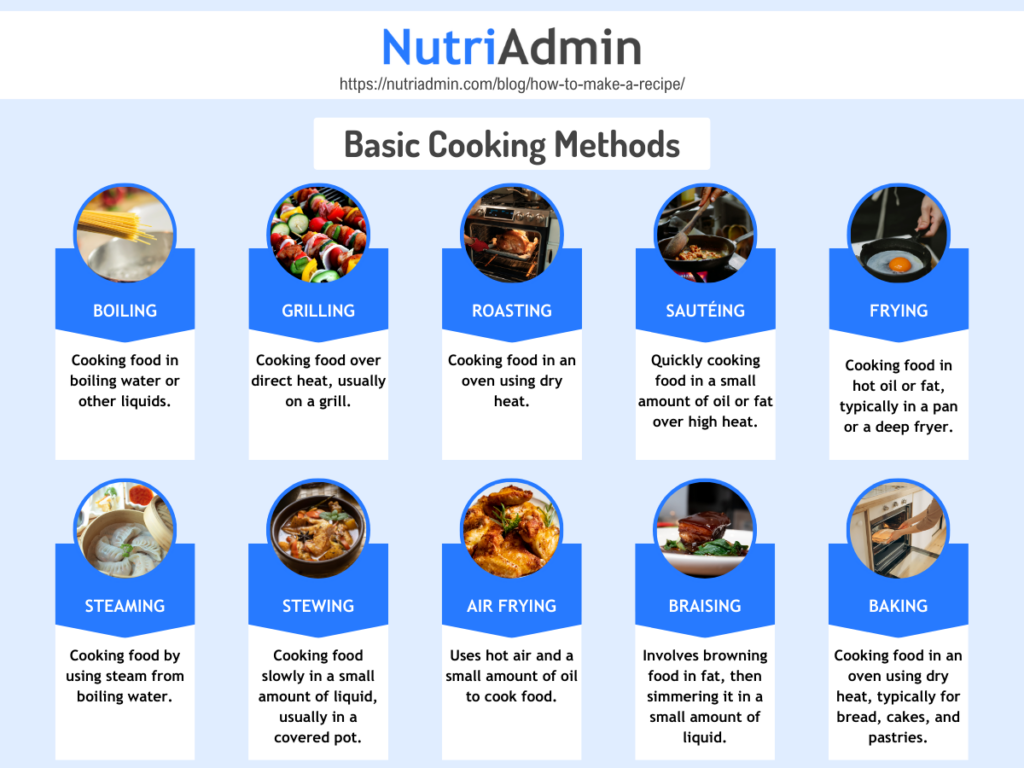
Step 4: Consider Flavor and Texture
Think about how to incorporate flavors and textures that will make the dish appealing and satisfying. Experiment with herbs, spices, and other flavor-enhancing ingredients.
Step 5: Test the Recipe
Once you have the recipe idea, test it in your own kitchen to ensure that your clients can create it themselves and that it tastes delicious. Taste and adjust as you go. Be prepared to adjust seasoning or other elements as needed to achieve the desired flavor profile. Document the entire process, including cooking times and temperatures, so that you can replicate it accurately in the future.
Step 6: Write Down Preparation and Cooking Instructions
Write down the preparation steps in a clear and organized manner. This should include how to prepare each ingredient and the order in which they will be combined. By following these steps, you can create a well-structured and tasty recipe that you and others can enjoy.
Step 7: Nutritional Analysis
Since the recipe is for meal planning, it is important to do a nutritional analysis. Firstly, it ensures that the meals meet the client’s dietary needs and health goals, such as weight management, specific nutrient intake, or dietary restrictions. This analysis helps in creating balanced and nutritious meal plans, taking into account the right proportions of essential nutrients like protein, carbohydrates, fats, vitamins, and minerals.
Additionally, it assists in identifying any potential deficiencies or excesses in the diet, allowing for adjustments to be made to optimize the nutritional content of the meals. Finally, nutritional analysis provides clients with a clear understanding of what they are consuming, empowering them to make informed decisions about their diet and overall health.
Step 8: Downloadable Recipe Format
Creating a recipe for meal planning with your own branding not only makes it look professional but also helps to establish your unique identity and style. Using your branding elements, such as your logo, colors, and fonts, can add a personal touch to the recipe, making it more memorable for your audience.
Additionally, it creates a cohesive look across all your meal planning materials, reinforcing your brand and making it recognizable. This can be particularly beneficial if you are sharing your recipes online or using them as part of your business.
Things to Consider When Creating Recipes for Meal Planning
When creating meal plan recipes for your clients, it is important to consider several key factors. It’s important to keep in mind that each client’s dietary needs and preferences can vary.
Some clients may be following a specific diet for personal reasons, others may have allergies or health conditions that require them to avoid certain foods, and some may simply have dislikes for certain ingredients. Understanding these principles can help you create and organize your recipes, ensuring that you can recommend recipes that your clients will actually find useful.
Additionally, if you have a blog and provide recipes, some of these factors can be used as categories to help your clients easily find the recipes they want.
Availability of Ingredients
When developing a recipe, consider your clients’ locations and ensure that the ingredients can be easily found in their area. You may want to research local markets and grocery stores to determine which ingredients are easily accessible. If the ingredients are difficult to find in their area, try to come up with alternatives.
Remember that some ingredients may not be available year-round due to seasonal changes. With this in mind, it may be necessary to adjust the recipe accordingly. By taking ingredient availability into account, you can create a recipe that is easy for your clients to prepare and that they can enjoy with minimal hassle.
Dietary Restrictions
If you cater to clients with dietary restrictions for health or personal reasons, ensure that your recipes would fit their needs. A section in your nutritional assessment form with questions about clients’ health and dietary restrictions can help identify if they need specific recipes.
For example, if you specialize in gut issues such as Candida, have vegan clients, or clients on keto, your recipes should cater to their needs. However, if you don’t have a specific niche, you may want to create recipes that are generally acceptable to most people regardless of their dietary restrictions. You can also prepare a few recipes that cater to common diets so you’re ready to serve clients with specific dietary needs.
Food Preferences
Some people may not like certain ingredients or flavors. Thus, it is important to create recipes that exclude common food dislikes, such as spicy dishes or raw food. In order to better understand your client’s food preferences, a food preference questionnaire would be useful.
Preparation and Cooking Time
In creating recipes for meal planning, it is important to consider practicality. Therefore, it’s important to take into account how much time a client is willing to spend cooking. Would they prefer to cook every meal or prepare their meals in advance?
In today’s fast-paced world, people are always short on time. As a result, preparing elaborate meals has become a luxury that not many can afford. Quick recipes are now the go-to option for most individuals.
However, if someone is planning to meal prep, they might opt for a recipe that takes more time but can be made in bulk. This way, they can save time and have healthy meals ready throughout the week.
Difficulty Level
Let’s be real; not everyone can cook. But, as a meal planner, you can make a difference by remembering this while creating your recipes.
A great way to do this is by creating recipes that are simple and easy to make. Alternatively, you should provide detailed recipe instructions to help even the most inexperienced cook create a tasty meal.
How can you create recipes with nutrition information?
There are several ways to do a nutritional analysis for the recipes you created. You can either use free resources or use paid tools like meal planning software.
Free Resources
You can take advantage of various free online food databases, such as the USDA FoodData Central. In addition to this, many other countries also offer their own food databases, providing a wide range of information on different food products.
Another great example is the Australian Food Composition Database website. It allows users to search for ingredients and conveniently access detailed nutritional information. Additionally, users can enter custom amounts in grams based on their recipe.
This feature saves time by automatically calculating the nutritional information for each ingredient based on the specific amount used.
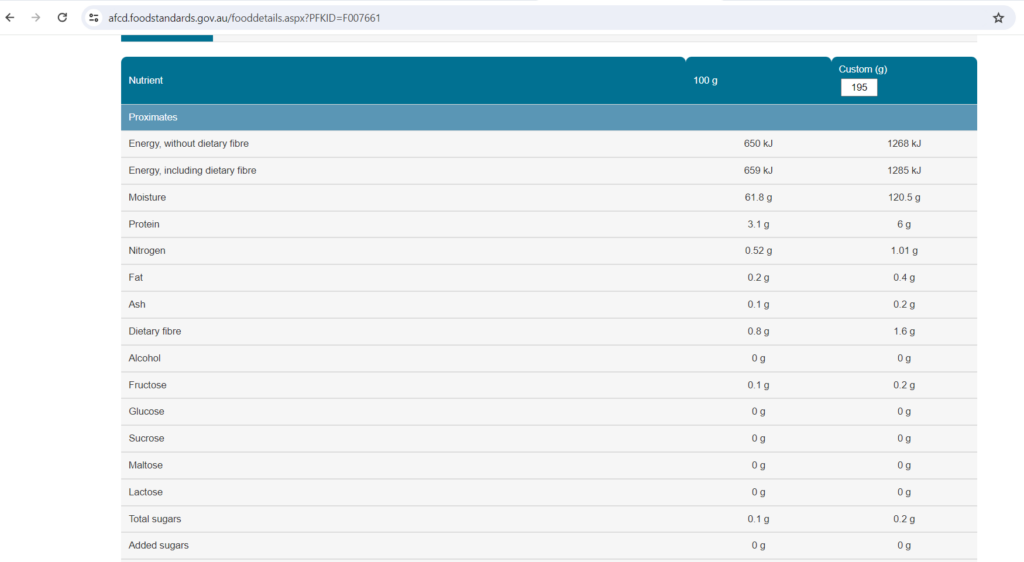
How can you create recipes with your branding?
When creating recipes with your branding, you can use user-friendly graphic design tools like Canva. There are many free templates available for you to use and customize to align with your branding.
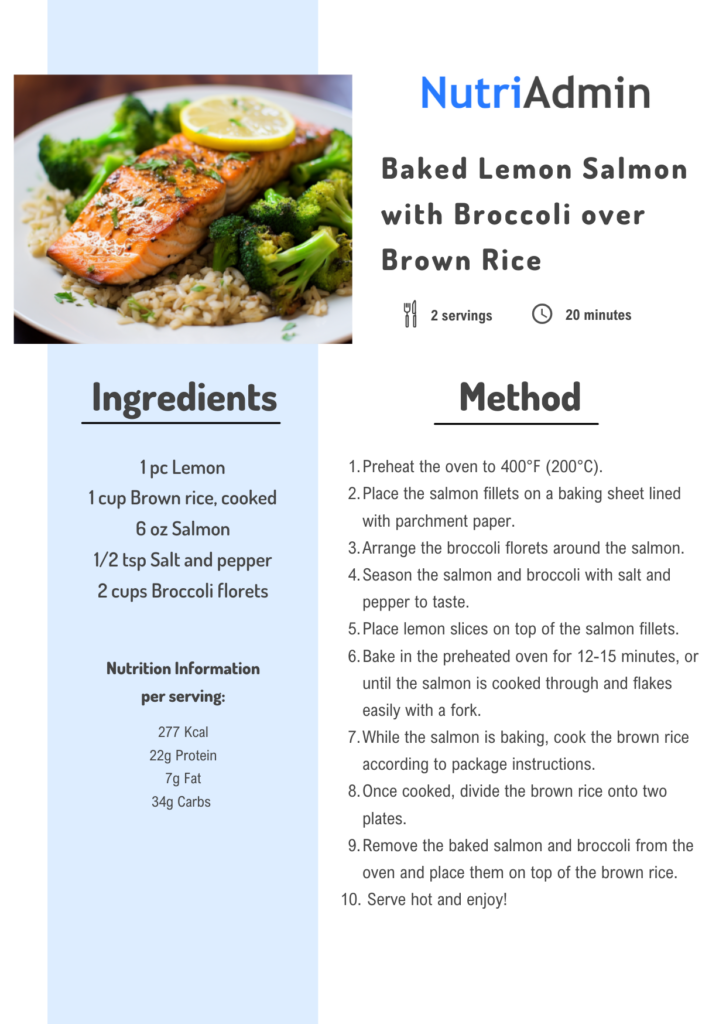
Alternatively, you can create a recipe template from the ground up by integrating graphic design elements, such as your logo, using consistent color palettes, and selecting clear and attractive fonts. By maintaining a cohesive visual style across your recipes, you can effectively represent your brand and create a professional and recognizable look for your recipes.
Recipes Management Software
As a nutrition or fitness professional, having a lot of recipes can be overwhelming to manage.
Investing in recipe management software would allow you to efficiently organize all your recipes in one secure location. It can also help conduct automatic nutritional analysis.
In NutriAdmin, we utilize the USDA FoodData Central, AUSNUT, and UK food databases to analyze the nutrition information for foods, recipes, and meal plans. This includes detailed breakdowns for macronutrients and micronutrients.
Additionally, it allows you to personalize and share your recipes with clients while maintaining your branding. You can conveniently share or download recipes with clients while keeping your personal branding.
Making Profit Through Recipe Creation
If you have a passion for cooking and creating new recipes, why not turn it into a way to supplement your income and attract new business?
Customized Meal Plans
Creating delicious and healthy recipes tailored to your client’s nutritional needs for their personalized meal plans can maximize their chances of achieving their health and fitness goals.
Learning how they are written can demonstrate your expertise in creating nutritious and enjoyable meals. This further solidifies your position as a trusted nutrition or fitness professional.
Grow Your Blog
Unlike the other examples, this does not immediately provide you with extra income. However, growing your nutrition or fitness blog can create more opportunities for your business.
- Establishing Authority and Credibility: Helps professionals establish themselves as experts in their field, gaining credibility and trust from their audience.
- Building a Supportive Community: Create a platform for like-minded individuals to come together, share experiences, and support each other.
- Attracting Potential Clients: Using SEO-optimized recipe blog posts in your marketing strategy can help you reach more people and attract more clients.
- Education and Awareness: Educate readers about the latest nutrition and fitness trends and raise awareness about important health issues.
- Networking and Partnerships: Open doors to collaborations with other professionals, influencers, and brands within the nutrition and fitness industry.
- Monetization Opportunities: Sponsored content, affiliate marketing, or selling your own products or services.
How does recipe creation play a part in all of this? Just think about how many people are constantly searching for new recipes online – it’s a huge number!
To help you visualize the volume of online recipe searches, here’s an SEO keyword research on low-calorie recipes. Just for this topic, thousands of people are searching online. Imagine the possibilities!
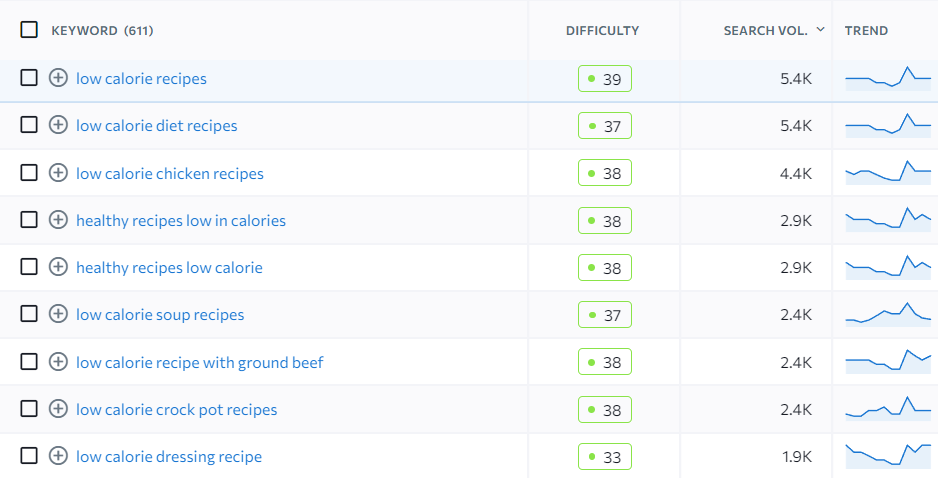
If you want to learn more about SEO to optimize the content you publish in your blog so that you can reach more people, you can read our comprehensive guide on SEO and Content Strategy.
Lead Magnets
A lead magnet is a marketing tool that attracts potential clients by offering something valuable, like a freebie. In exchange, potential clients provide their contact information. In the context of nutrition and fitness, professionals can use free recipes to entice potential clients interested in their services.
This helps build a list of potential clients, establish authority, and increase the likelihood of converting them into paying clients by offering ongoing valuable content and offers.
Digital Cookbooks
Did you know that e-books are one of the top in-demand digital products this year? Forecasts indicate that e-book publishing revenue could reach nearly $5.4 billion in the United States by 2027.
This means e-books like digital cookbooks have a great potential to generate passive income in addition to your current services.
Becoming a Recipe Developer
As a nutrition or fitness professional, you can make money by writing a recipe. You can collaborate with food companies to develop recipes for their products. Alternatively, you can offer recipe development services to restaurants and food establishments.
Additionally, you can work as a freelancer, creating recipes for websites, magazines, and other publications. By leveraging your expertise in nutrition and fitness, you can create innovative and nutritious dishes that cater to the needs and preferences of a health-conscious audience.
Summary
Creating recipes involves understanding the essential components, such as the name, ingredient list, step-by-step instructions, and additional details like preparation time, servings, and nutritional information. They are written to document and share instructions for preparing dishes consistently and accurately.
Learning to create recipes requires experimentation, understanding cooking techniques, and practicing regularly. When creating recipes for meal planning, consider factors like ingredient availability, dietary restrictions, food preferences, preparation time, and difficulty level.
To incorporate nutrition facts, use free online food databases or recipe analysis software. Graphic design tools or recipe management software can be used to add branding elements and efficiently organize and share recipes.
Recipe creation can be a source of income by offering customized meal plans, growing a blog, selling digital cookbooks, or working as a recipe developer for companies and publications.
